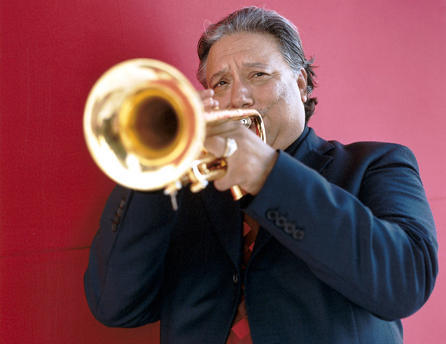Arturo Sandoval offers robust playing in Miami concerto premiere

Arturo Sandoval and the Miami Symphony Orchestra gave the premiere of Carlos Rivera's "Concierto de Miami" Sunday night at the Arsht Center.
The great jazz trumpeter Arturo Sandoval came to the Arsht Center Sunday to join the Miami Symphony Orchestra for the world premiere of an evocative, high-energy work inspired by the city of Miami.
The Concierto de Miami by Carlos Rivera is the product of a joint commission by the Miami Symphony Orchestra and the famed El Sistema Simon Bolivar Youth Orchestra of Venezuela. Rivera, who spent his teen and young adult years in Miami, graduating from Belen Jesuit Preparatory School, composed an optimistic and atmospheric tribute to the city. Also on the program, led by conductor Eduardo Marturet and forming part of the Festival Miami series, were Beethoven’s Symphony No. 7 and Ravel’s Bolero.
The 14-minute, single-movement Concierto opens with a fanfare for solo trumpet, soon taken up by the full orchestra, with broad harmonies that clearly invoke Aaron Copland’s Fanfare for the Common Man. It proceeds swiftly through a variety of moods and styles, with a strong Latin-American tone. A smooth, dusky section calls up the image of a sleek 1950s nightclub. A romantic melody follows on the muted trumpet, under a shimmering accompaniment of violins, before the work gathered speed and volume for its climactic conclusion.
Although the work evokes a variety of Miami-oriented musical styles, there was no sense of the piece as mere travelogue or pastiche with an obligatory nod to the city’s demographics. The work was held together by a strong melodic sense, an emphasis on the trumpet and a firm sense of structure
The Concierto didn’t offer Sandoval a lot of screaming high notes, although it called for some extremely rapid playing, which he handled easily. Sandoval, who alternated between a trumpet and a flugelhorn, played in a robust, throaty style.
The packed crowd at the Arsht Center—some of whom were visibly disappointed when the vigorously applauded Vivace of the Beethoven turned out to be only its first movement—responded enthusiastically to the new piece, with a long standing ovation. It’s too soon to tell whether Rivera has done for Miami what Gershwin did for New York and Eric Coates did for London, but this is an accessible and highly entertaining new work.
The concert opened with a performance of Beethoven’s Symphony No. 7 that made up in vigor what it occasionally lacked in polish. Marturet led the first movement in an animated style, with lots of headlong power. The solemn march of the second movement was the most effectively performed of the symphony, moving rather than plodding, with Marturet keeping reserves of power for the climaxes. In the last movement there were some horn bloopers, and strings got buried under the brass at times, but it was a well-paced, energetic performance.
The concert concluded with Ravel’s Bolero, performed in a far more polished manner than the Beethoven, with the orchestra generating a smooth blend of sounds as Marturet skillfully led the ensemble through the work’s long crescendo.